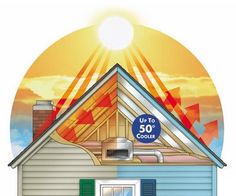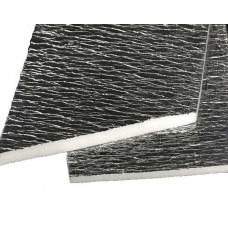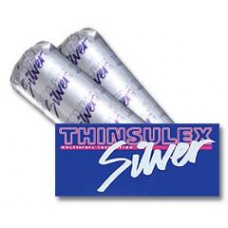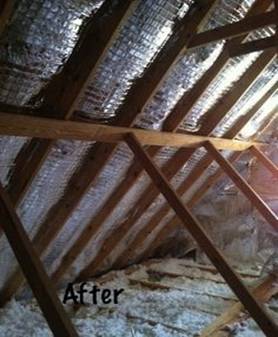How Can Radiant Barriers Save Energy

Simple Ways to Improve Your Home’s Energy Efficiency
There are a lot of ways you can save energy within your home, starting from the areas that are the greatest source of heat loss or gain. Although, when thinking about energy savings, people usually have winter months in mind, when they need additional energy to heat up their home, a lot of energy can also be saved during summertime. Basically, during those hot summer months, we need extra energy to cool down our interior, why this is another way we can cut down the cooling costs. Although heat gain can come from a lot of different sources, like old and poorly insulated windows and draughty doors, uninsulated walls and floors, a lot of amount of heat usually gets in through loft spaces and roofs since these are under the direct influence of the sun and can absorb and emit a lot of heat, even during nighttime. So, this is the area you should firstly take care of, why we answer the question on how can radiant heat barriers save energy.
How Do Radiant Barriers Work?
Unlike traditional insulation materials that basically prevent or minimize heat flow through a material by trapping it within and thus affecting heat transfer through conduction and convection, radiant heat barriers affect radiant heat transfer. Namely, all materials and surfaces can reflect and radiate a certain amount of energy that has been previously collected. Some materials, depending on their structure and characteristics, such as shinier and lighter surfaces, tend to reflect more energy than other surfaces. This is why, in order of minimizing the heat that is radiated into your home, most commonly through attic and roof space, you need a proper barrier that will prevent just that. And that is how radiant heat barriers work, since they are usually made as thin sheets of aluminum foil that not only reduce the temperature within your loft during summer, but also prevent it to be transferred to the rest of your home, by reflecting it of the roof surface. In order of fully understanding just how useful these can be, you need to know that studies have shown that proper barriers can remove up to 95% of radiant heat and reduce up to 50% of overall heat transfer. Another useful thing is that these can also help you deal with some other potential issues that are common for attic spaces, such as condensation which can easily form under the roof and cause timber to rot and warp and mold to form.

Just how energy efficient a radiant heat barrier shall however depend on many factors, including:
-
Existing insulation. Here, there are two ways you can look at the insulation factor. Firstly, the cost efficiency of the installed barrier will depend on whether you already have highly efficient insulation installed. If this is the case, then the insulation is probably doing a great job in providing a protective wrap for the attic space, why the barrier will not contribute as much to the energy saving which are already realized. On the other hand, if you have no insulation installed, then the barrier will be more efficient but please note that it will still not be quite enough. This is why you can opt for specially designed insulation materials with reflective foil as the radiant heat barrier already installed and incorporated onto the surface of insulation (usually attached to some rigid insulation material), thus affecting not only radiant heat transfer, but also heat loss through convection and conduction.


-
Climate region. Now, as upper mentioned, radiant barriers are much more efficient in controlling and reducing heat gain rather than heat loss why they will be more efficient in warmer rather than colder climates. Now, don’t get us wrong, barriers can also be very useful in cold climates as well, just not as cost-efficient since it will take more time for them to pay for itself.
Are Radiant Barriers Cost-Effective?
The cost effectiveness of a radiant heat barrier will depend on how much it costs initially and how long will it take for it to pay off. The costs of installing a barrier will depend on a few factors. Firstly, it will depend on the type of barrier you chosen, since some materials are more expensive than others. However, bear in mind that although initially more expensive, some materials are also more efficient and it will thus take less time for them to pay for themselves, why they can be more cost-efficient on the long run. For example, spray radiant barriers are initially less expensive than foil ones, but reflective foils are much more efficient. There are also a number of other materials you can choose such as metal shingles, reflective paints, reflective chips etc.

Another important factor that will affect the cost of your radiant heat barrier is whether you already have insulation installed. Namely these barrier themselves are not insulators, why they need to be installed under or over some insulation material, in order of reaching their full potential. Again, as upper mentioned, you can opt for some insulation material that has reflective foil incorporated or you will have to install them separately.
Finally, another thing to keep in mind is the radiant heat barrier installation cost. Basically, if you decide to install the barrier yourself (which is possible for some materials) than you will spend less money than if you had to hire a professional for the job. However, be careful here, since if you have no experience or required level of skills to do the job properly, you are better of hiring a professional contractor, since this way you will avoid the risk of installing the barrier improperly and thus affect its characteristics and minimize its positive effects.
Buy radiant barriers online and get a fast delivery. Visit our webshop or contact us via email or phone.




































































































































